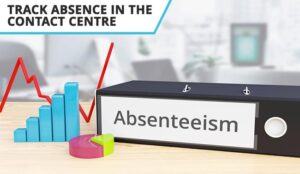Absence is a big problem across the industry. It seems particularly acute on a Monday morning. In some call centres up to 10% are absent at any one time.
Here are 16 tips to help manage the issue…
1. Create an absence policy
If you don’t have one already, create an absence policy to balance employee and employer needs. These written guidelines are for your employees and should set out holiday entitlements, procedures for reporting absence and terms and conditions of employment.
When compiling an absence policy it is often best to do so in consultation with line managers, employee representatives, and trade unions if necessary. Policies must spell out employees’ rights and obligations when taking time off work; they must also contain any information on terms and conditions relating to incapacity for work due to sickness or injury, including any provision for sick pay. Items you might wish to include are:
- Permitted time off
- How employees should notify you in case of sickness, lateness, etc.
- When to submit a medical certificate (or self certificate)
- Sick-pay arrangements
- Whether employees are required to attend a return-to-work interview after absence
- Health and safety, drug, alcohol, grievance and discipline policies
- What happens when employees are non compliant with the absence policy
- It is also advisable to detail who is responsible for keeping employees’ attendance records, and who will have access
2. Communicate the policy
There’s little point in having an absence policy if you don’t communicate it to employees, so publicise the policy through team briefings, leaflets, information in pay packets, handbooks, intranets, etc.
3. Enforce and manage the absence policy
Any absence policy needs to be monitored and enforced consistently and fairly throughout the organisation to curb unscheduled absence and unauthorised sick days. More than half of employed adults believe their work performance is negatively impacted when attendance policies are not fairly enforced.
When managing short-term absence you may need to consider the following interventions:
- Review of individual attendance
- Return-to-work interviews
- Involving line managers and occupational health professionals
- Restricting sick pay
- Disciplinary procedures for unacceptable levels of absence
When managing long-term absence it is vital that you have a formal strategy in place to help employees get back to work after a prolonged period of absence. You should consider the following:
- For serious long-term absence obtain Access to Medical Records from employees’ Medical Advisor to assess ways in which the company can assist in the return to work
- Return-to-work interviews
- Changes to work patterns and environment
- Rehabilitation programmes
- Occupational health environment
- Line management involvement
- Restricting sick pay
4. Return-to-work interviews
These interviews can be useful in identifying absence problems at an early stage. You should conduct return-to-work interviews in order to:
- Welcome employees back
- Check they are well enough to be at work
- Update employees on any news while they were away
- Identify the cause of the absence
- Find out whether they have a disability and whether the provisions of the Disability Discrimination Act 1995 apply, such as making a reasonable adjustment
- Discuss any help you might provide to ease the employee’s return to work
- Establish if their sickness is work related and whether there are any health and safety issues you need to address.
Interviews should be conducted sensitively to find out if there are any underlying issues such as domestic problems. Remember the employee might be building up to revealing personal information about themselves, so find a quiet private place to hold the discussion.
Many managers shy away from return-to-work interviews for fear of a confrontational show down. Prepare before the interview and think about the following:
- Questions you might ask – open-ended ones will get the conversation flowing
- Have employee records at hand
- Consider how the employee feels
- Your body language – be sympathetic
- Have there been any patterns in absence?
- Plan a getting back to work programme if the employee has been away for a long period
- Update the employee about any changes since they’ve been absent
- You might have to take disciplinary action if you are unhappy with the explanations for the absences or poor timekeeping
- Have an open mind, agree a shared action plan where possible, but don’t make any hasty decisions at the meeting
5. Provide incentives for excellent attendance
In large organisations, time and attendance systems are an invaluable tool for tracking and reporting on attendance levels. Many organisations effectively use perfect attendance bonuses or set targets as an incentive to reduce absence levels.
6. Be realistic
Sometimes people really do need to take some ‘mental health’ time out that simply cannot be planned. Allow employees to take a maximum number of days each year as ‘Duvet Days’ at short notice. This will likely improve morale and get better results from your employees in the long term.
7. Consider unpaid leave or options to buy more holiday time
Planned absence is always easier for a business to manage than unscheduled absence. Offer employees the opportunity to book unpaid leave up to a maximum number of days or buy additional holidays at the start of the year.
8. Working conditions

Simon Macpherson
Provide other incentives to encourage good attendance such as pleasant working conditions, ensuring specialist/ergonomic equipment is provided where it is needed or healthcare and counselling facilities.
9. Make controlling absence a business priority
There’s no excuse not to be in control of absence. Business tools are available to control and monitor absence levels and trends – you can even set the parameters to alert you to all unscheduled absence the moment it happens, not several days after the event.
10. Continuous feedback
An absence policy is something that should be reviewed regularly. Collect feedback from employees and update your policy to suit your employee and business needs.
Simon Macpherson is Senior Director of Business Developments & Operations at Kronos
11. Formal absence process
Using a formal process of written and verbal warnings seems to have some effect. Some people are not scared by this, however.
12. Sackings
Once someone has been sacked for absences it does tend to send shock waves through the call centre for a period of time.
13. Sickness bonus
One scheme that seems to work is that of a sickness bonus. If you have not taken any time off for illness in 12 months then you get given an extra day of holiday. Many people feel very proud about this.
14. Peer pressure can work
If a team realise that they have to take on extra workload due to an absence they can often put indirect pressure on an employee to improve absence.
15. Absence call-backs
Quite a common scheme is to use call-backs. The employee has to phone in sick before 9.30am. A more senior team manager would then call them back later in the day to find out how they were feeling. In one case the phone back had to be before 11.30am and in another case the phone call could be at any time during the day.
The best method is to follow a standard script for all call-backs. This ensures that the message is consistent and helps to avoid the claim that it could be seen as bullying people back to work.
Another variation is to ask the person to call you back later in the day to let you know how they are getting on.
It was felt that this helped to discourage people taking the day off as a holiday and kept them at home. It was also noted that you had to be careful that this would not be seen as bullying.
A couple of people tried using a call-answering service staffed by real nurses, but found that absence levels actually rose. Patient confidentiality then got in the way of finding out the real reasons for absence.
If someone is off on self-certified sickness ask them to phone in every day that they are off.
16. Duvet Days
One call centre has introduced a Duvet Days scheme. Called “Personal Choice Days”, you are allowed to take up to three days per year that come out of annual leave. You have to phone in by 9.30am and there are a maximum number of days that can be taken.

Jonty Pearce
Some people try to book these days in advance but they are encouraged if possible to take them as scheduled annual leave.
They view the scheme as a real success story as they feel that people are more empowered. It has cut sickness and absence down by around 40%. Anecdotally, people who have a hangover are then able to take a Duvet Day, rather than having to take a sickness day.
However, they have had to limit the number of Duvet Days as there can be problems the day after some major sporting events.
Jonty Pearce is the Editor, Call Centre Helper
Author: Jo Robinson

13 Comments
-
Simon’s point #5 (Provide incentives for excellent attendance) is very important. The best way to implement the policy is to reward attendance every day plus bonus rewards for five days in a row (note there is a major difference between M-F and five days in a row). This follows one of the main points of a successful incentive program. Here is a link to an article on the topic http://snowflyincentives.blogspot.com/2010/01/four-principals-behind-successful.html
Robert Cowen
8 Apr at 13:49
-
It’s a common sense and useful to see all the strands pulled together in one place. But, just as there is little point in having a policy unless it is communicated (1. and 2.), ergonomic equipment (8.) may be counterproductive unless users are trained as to how to use it. It may even be pointless unless the need for it has been professionally established, as opposed to being its being a user request.
Max Klein
12 Apr at 00:19
-
This article is really excellent. i agree with 5,7,8 above it will encourage employee to keep up with regular attendance, the company could make it like an award, say at the end of every month . As for the absence policy i think it is really nice especially 1,2,3 says it all, also suspension & sacking will help.
During team briefing, staffs should be encouraged.
Ruth Asuquo
14 Apr at 09:58
-
Some interesting comments, but more so look at the key drivers, Are the UPA’s one off instances or more substantial. What are the dynamics of team ? Creating a team focused culture i.e. team goals as oppose to individual goals. You will find the upa level will decrease as you localise the team members focus rather than the company.
Rewarding staff for turning up to work ? Sorry i don’t agree, t/m’s shouldn’t be rewarded for doing a minimum.
As a part of our upa management we organise for the t/m to be on a upa management plan :
1 – medical certificates to be provided on all absences
2 – no additional hours or overtime
3 – any additional task to be removed ( reward your workers who attend work and also have a positive mindset)
This upa managment plan is discussed on a regular basis inconjunction with their one on one.
Paul Dinys
6 May at 00:07
-
Seasonal Absence Syndrome.
It sounds more like a made up term than something to be taken seriously, but, it defines a common problem affecting many UK businesses. To put it simply – whether it’s the first fall of snow or the hottest day of the year, absence rates can and usually do increase significantly in relation to the weather.
Seasonal Absenteeism:
Summer has its own challenges as does winter. We spend eight months of the year waiting for summer to come around and with the increase in temperatures comes an increase in absenteeism as employees take a day of at the expense of the business. Winter brings fresh problems, how many staff will enjoy a day off to ‘play’ in the snow? The cost and implications of this have a considerable effect on efficiency, profitability and team morale, but what is the best way to tackle it and should you?
You already pay your employees to come to work, so what more can an employer do? How do you encourage employees not to take days off for no reason other than the weather is favourable? Do you positively acknowledge your staff for the days on which they do come to work, adopting a ‘carrot’ approach or do you implement a ‘stick’ approach and refuse to pay sick pay for the first few days and risk penalising those that are genuinely ill? Neither of these options is perfect and the approach needs to be balanced to avoid being discriminatory and generate resentment amongst staff.
The ‘Stick’
Two large super market chains adopted a tough ‘stick’ approach to tackle their spiralling absenteeism rates. They no longer pay sick pay for the first 3 days of leave and, although one saw a drop of 5% in absenteeism rates, it also brought widespread demotivation as staff felt unable to take a day off for genuine ill health.
The implications of the ‘stick’ mean that staff often come to work when they should, for their own health and the health of their colleagues, be at home. Those that are unwell should be actively encouraged to stay at home to prevent widespread infection rather than being forced, by the sick-leave policy, to come to work.
The ‘Carrot’
On the other hand a well known mail delivery service introduced a ‘carrot’ approach to tackling high absenteeism rates by rewarding employees who didn’t take any sick days in a given period. Although the company saw an 11% increase in attendance this approach could have legal implications. Staff are rewarded for not taking days off, but what if such an event was of an unavoidable nature such as, a funeral, religious holiday or activity, public duty or disability? Could a claim of discrimination be sought for someone upholding a mandatory duty and losing out on the reward given to others through no real fault of their own?
‘A Balanced Approach’
Neither Carrot nor Stick will, in isolation, deliver the desired result and a balanced approach is key. Have in place a disciplinary procedure for unauthorised absences and there are tools, such as the Bradford Factor, that can help you identify and monitor high-risk individuals. But at the same time, it is important to encourage good attendance and one method is to provide incentivisation where an unconscious by-product of the incentive campaign is a reward for good attendance. This low-key approach to rewarding attendance is an excellent half-way house providing as it does gentle and covert promotion of good attendance while avoiding many of the political and occupational difficulties that often accompany openly rewarding basic attendance.
Incentive campaigns that reward achievement and improve performance can be designed to deliver, as secondary benefits, behavioural and cultural improvements such as regular attendance etc. By having multiple targets such schemes can be an excellent weapon with which to combat unscheduled absence. Incentivisation offers a chance to counter absenteeism in a cost-effective and attractive way.
Niall McCrae
28 Jul at 17:52
-
Some employees aren’t even aware of their absence patterns. We’ve worked with companies that have put simple absence management software in place to show the employees the patterns of their own absence. When given the data showing how often they were sick on what day of the week they quickly see if there is a Monday or Friday absence pattern.
“Self service” reporting of sick leave through such systems also helps but it would be interesting to see if anybody has solid stats or case studies on it.
John
John Dennehy
23 Aug at 17:55
-
Long-term absence can be managed, but organisations who are prepared to work with the employee in an atmosphere of continued support will experience better outcomes.
If the employee/employer relationship breaks down then absence and the future of the employee can become an expensive and time consuming issue. It is far better to provide appropriate support so that both parties maintain a meaningful dialogue. The result is that both parties negotiate an acceptable long term plan. This approach will often end with the absent employee returning to work in time and working at full capacity. When cases have a positive conclusion the benefits are significant both to the employer and the employee.
Mark Millard
20 Sep at 12:36
-
If I may refresh this thread with a question:
How do you deal with childcare related absence? Obviously we have/want to be as supportive as we can but where do you draw a line? I have significant absence from mothers with small children who only work part time in the first place. Having exhausted reasonable amounts of paid emergency leave, we also offer to make up lost time which due to childcare arrangements mostly does not work. It’s then unpaid which is a loose/loose situation for both parties. Any views? Many thanks!
Jurgen Brieger
5 Dec at 19:47
-
Niall, I believe you are right about the balanced approach. I have spoken to a company recently who have a policy similar to the company in your ‘Carrot’ example. One way to work around the potential discrimination issue is to have a system that can differentiate these types of absence and choose whether to count them or towards the incentive.
John, simple absence management software has it’s limitations when defining genuine unplanned absence. We have seen a 24% decrease in unplanned absenteeism throughout our client base by using the Bradford Factor and allowing employees to see their own sickness record. The most important thing in the first instance is a robust staff absence policy then reinforce this with the right tools to track it.
Jurgen, childcare absences can be a big issue(and an issue close to my heart as a new father). Our service at least allows you to create a specific absence type for this so you can track it and then if it becomes excessive you can take action but it is one of the most tricky situations to deal with that I can think of.
Matthew Scrimshire
11 Nov at 18:19
-
Coming from a worker in a call center. I think every one is missing the point. As a hard worker, I don’t want to be absent, but the call volume has a lot to do with it. Also, the company trying to get a much work out of the worker as possible. I think there should be a union created to protect the employee. I thought it was just my company that was insane, but I see it’s the whole industry. I’m a college graduate with a business degree, and studied business psychology on how to motivate workers. If the knowledge is out there why do you keep blaming the call center worker. It may be that the blame is on management not providing a better work environment and may beshould work the job at ground level like a true leader to get a better understanding of the stress.
Bren
17 Mar at 16:01
-
Totally agree with Ben — and I would add that it’s really hard when your boss makes a point of telling you that if you are sick you must stay home to keep the illness from spreading to the rest of the office but then gives you flack when you do call off.
Tara researching call offs
2 Mar at 00:41
-
If I have no one too look after my son who is eight during the school hols can I be put on the Bradford Scale
darren
2 Sep at 19:13
-
I will try the call back and return to work interview. This is one of my worst problem, absences. I understand they are stressed out but I am a leader that takes calls too with more tasks in hand. When they’re busy, I am busy. When they’re not taking calls, then I have reports to do.
P1nk
31 Aug at 02:44
Get the latest call centre and BPO reports, specialist whitepapers and interesting case-studies.






































Simon’s point #5 (Provide incentives for excellent attendance) is very important. The best way to implement the policy is to reward attendance every day plus bonus rewards for five days in a row (note there is a major difference between M-F and five days in a row). This follows one of the main points of a successful incentive program. Here is a link to an article on the topic http://snowflyincentives.blogspot.com/2010/01/four-principals-behind-successful.html
It’s a common sense and useful to see all the strands pulled together in one place. But, just as there is little point in having a policy unless it is communicated (1. and 2.), ergonomic equipment (8.) may be counterproductive unless users are trained as to how to use it. It may even be pointless unless the need for it has been professionally established, as opposed to being its being a user request.
This article is really excellent. i agree with 5,7,8 above it will encourage employee to keep up with regular attendance, the company could make it like an award, say at the end of every month . As for the absence policy i think it is really nice especially 1,2,3 says it all, also suspension & sacking will help.
During team briefing, staffs should be encouraged.
Some interesting comments, but more so look at the key drivers, Are the UPA’s one off instances or more substantial. What are the dynamics of team ? Creating a team focused culture i.e. team goals as oppose to individual goals. You will find the upa level will decrease as you localise the team members focus rather than the company.
Rewarding staff for turning up to work ? Sorry i don’t agree, t/m’s shouldn’t be rewarded for doing a minimum.
As a part of our upa management we organise for the t/m to be on a upa management plan :
1 – medical certificates to be provided on all absences
2 – no additional hours or overtime
3 – any additional task to be removed ( reward your workers who attend work and also have a positive mindset)
This upa managment plan is discussed on a regular basis inconjunction with their one on one.
Seasonal Absence Syndrome.
It sounds more like a made up term than something to be taken seriously, but, it defines a common problem affecting many UK businesses. To put it simply – whether it’s the first fall of snow or the hottest day of the year, absence rates can and usually do increase significantly in relation to the weather.
Seasonal Absenteeism:
Summer has its own challenges as does winter. We spend eight months of the year waiting for summer to come around and with the increase in temperatures comes an increase in absenteeism as employees take a day of at the expense of the business. Winter brings fresh problems, how many staff will enjoy a day off to ‘play’ in the snow? The cost and implications of this have a considerable effect on efficiency, profitability and team morale, but what is the best way to tackle it and should you?
You already pay your employees to come to work, so what more can an employer do? How do you encourage employees not to take days off for no reason other than the weather is favourable? Do you positively acknowledge your staff for the days on which they do come to work, adopting a ‘carrot’ approach or do you implement a ‘stick’ approach and refuse to pay sick pay for the first few days and risk penalising those that are genuinely ill? Neither of these options is perfect and the approach needs to be balanced to avoid being discriminatory and generate resentment amongst staff.
The ‘Stick’
Two large super market chains adopted a tough ‘stick’ approach to tackle their spiralling absenteeism rates. They no longer pay sick pay for the first 3 days of leave and, although one saw a drop of 5% in absenteeism rates, it also brought widespread demotivation as staff felt unable to take a day off for genuine ill health.
The implications of the ‘stick’ mean that staff often come to work when they should, for their own health and the health of their colleagues, be at home. Those that are unwell should be actively encouraged to stay at home to prevent widespread infection rather than being forced, by the sick-leave policy, to come to work.
The ‘Carrot’
On the other hand a well known mail delivery service introduced a ‘carrot’ approach to tackling high absenteeism rates by rewarding employees who didn’t take any sick days in a given period. Although the company saw an 11% increase in attendance this approach could have legal implications. Staff are rewarded for not taking days off, but what if such an event was of an unavoidable nature such as, a funeral, religious holiday or activity, public duty or disability? Could a claim of discrimination be sought for someone upholding a mandatory duty and losing out on the reward given to others through no real fault of their own?
‘A Balanced Approach’
Neither Carrot nor Stick will, in isolation, deliver the desired result and a balanced approach is key. Have in place a disciplinary procedure for unauthorised absences and there are tools, such as the Bradford Factor, that can help you identify and monitor high-risk individuals. But at the same time, it is important to encourage good attendance and one method is to provide incentivisation where an unconscious by-product of the incentive campaign is a reward for good attendance. This low-key approach to rewarding attendance is an excellent half-way house providing as it does gentle and covert promotion of good attendance while avoiding many of the political and occupational difficulties that often accompany openly rewarding basic attendance.
Incentive campaigns that reward achievement and improve performance can be designed to deliver, as secondary benefits, behavioural and cultural improvements such as regular attendance etc. By having multiple targets such schemes can be an excellent weapon with which to combat unscheduled absence. Incentivisation offers a chance to counter absenteeism in a cost-effective and attractive way.
Some employees aren’t even aware of their absence patterns. We’ve worked with companies that have put simple absence management software in place to show the employees the patterns of their own absence. When given the data showing how often they were sick on what day of the week they quickly see if there is a Monday or Friday absence pattern.
“Self service” reporting of sick leave through such systems also helps but it would be interesting to see if anybody has solid stats or case studies on it.
John
Long-term absence can be managed, but organisations who are prepared to work with the employee in an atmosphere of continued support will experience better outcomes.
If the employee/employer relationship breaks down then absence and the future of the employee can become an expensive and time consuming issue. It is far better to provide appropriate support so that both parties maintain a meaningful dialogue. The result is that both parties negotiate an acceptable long term plan. This approach will often end with the absent employee returning to work in time and working at full capacity. When cases have a positive conclusion the benefits are significant both to the employer and the employee.
If I may refresh this thread with a question:
How do you deal with childcare related absence? Obviously we have/want to be as supportive as we can but where do you draw a line? I have significant absence from mothers with small children who only work part time in the first place. Having exhausted reasonable amounts of paid emergency leave, we also offer to make up lost time which due to childcare arrangements mostly does not work. It’s then unpaid which is a loose/loose situation for both parties. Any views? Many thanks!
Niall, I believe you are right about the balanced approach. I have spoken to a company recently who have a policy similar to the company in your ‘Carrot’ example. One way to work around the potential discrimination issue is to have a system that can differentiate these types of absence and choose whether to count them or towards the incentive.
John, simple absence management software has it’s limitations when defining genuine unplanned absence. We have seen a 24% decrease in unplanned absenteeism throughout our client base by using the Bradford Factor and allowing employees to see their own sickness record. The most important thing in the first instance is a robust staff absence policy then reinforce this with the right tools to track it.
Jurgen, childcare absences can be a big issue(and an issue close to my heart as a new father). Our service at least allows you to create a specific absence type for this so you can track it and then if it becomes excessive you can take action but it is one of the most tricky situations to deal with that I can think of.
Coming from a worker in a call center. I think every one is missing the point. As a hard worker, I don’t want to be absent, but the call volume has a lot to do with it. Also, the company trying to get a much work out of the worker as possible. I think there should be a union created to protect the employee. I thought it was just my company that was insane, but I see it’s the whole industry. I’m a college graduate with a business degree, and studied business psychology on how to motivate workers. If the knowledge is out there why do you keep blaming the call center worker. It may be that the blame is on management not providing a better work environment and may beshould work the job at ground level like a true leader to get a better understanding of the stress.
Totally agree with Ben — and I would add that it’s really hard when your boss makes a point of telling you that if you are sick you must stay home to keep the illness from spreading to the rest of the office but then gives you flack when you do call off.
If I have no one too look after my son who is eight during the school hols can I be put on the Bradford Scale
I will try the call back and return to work interview. This is one of my worst problem, absences. I understand they are stressed out but I am a leader that takes calls too with more tasks in hand. When they’re busy, I am busy. When they’re not taking calls, then I have reports to do.